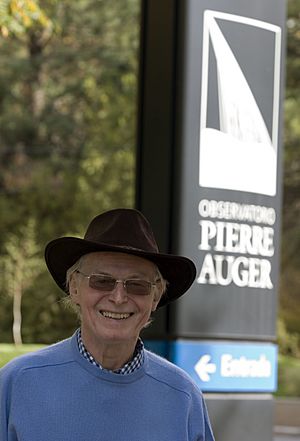Alan Andrew Watson facts for kids
Quick facts for kids
Alan Watson
|
|
|---|---|

Watson at the Pierre Auger Observatory, Malargue, Argentina in 2008
|
|
| Born |
Alan Andrew Watson
26 September 1938 |
| Nationality | Scottish |
| Alma mater | University of Edinburgh |
| Known for | Haverah Park, Pierre Auger Observatory |
| Scientific career | |
| Fields | Ultra-high energy cosmic rays, ultra-high energy gamma-rays and high energy astrophysics |
| Institutions | University of Leeds |
| Thesis | Physics of condensation of water vapour (1964) |
| Doctoral students | Clement Pryke |
Alan Andrew Watson, a Fellow of the Royal Society (FRS), was born on September 26, 1938, in Edinburgh, Scotland. He is a physicist and a retired professor at the University of Leeds in England. He is known for his important work studying very powerful particles from space, called cosmic rays.
Contents
Studying Science
Watson went to the University of Edinburgh. In 1960, he earned a top degree in physics. He then continued his studies and received his PhD in 1964. His PhD research was about how water vapor turns into liquid, which he studied using special equipment called cloud chambers.
After finishing his PhD, Watson started working at the University of Leeds in 1964. He became very interested in studying high-energy cosmic rays, which are tiny particles that travel through space at incredible speeds. He also studied ultra-high energy gamma rays and high-energy astrophysics, which is the study of how these powerful particles behave in the universe.
His Work and Discoveries
Watson became a full professor of physics at the University of Leeds in 1984. Before that, he was a "reader" (a senior academic position) in particle cosmic physics. He retired in 2003 and was given the title of "emeritus professor," which means he is a retired professor who still helps out and is highly respected.
The Haverah Park Project
From 1964 until the early 1990s, Watson was a key scientist in a big UK project called the Extensive Air Shower project at Haverah Park. He led the project from 1976. This project helped scientists understand cosmic rays better. They found out how much energy these particles had, what they were made of, and where they came from. For about 15 years, Haverah Park was considered the best project in the world for studying cosmic rays.
Research at the South Pole
From 1987 to 1994, Watson was the main scientist from the UK for a project called SPASE. This project was carried out at the South Pole with scientists from the University of Delaware in the USA. At first, they were looking for gamma-rays from a huge star explosion called SN1987A. Later, the project grew and worked with the AMANDA part of the IceCube neutrino project. This collaboration helped them study what cosmic rays were made of, especially those with very high energy.
Discoveries at Whipple Observatory
In 1994, while working at the Fred Lawrence Whipple Observatory, Watson helped make an important discovery. He played a big part in finding out that a galaxy called Markarian 421 was sending out bursts of very high-energy gamma rays. This was an exciting finding for astronomers.
The Pierre Auger Observatory
Watson, along with another scientist named J W Cronin, was very important in creating the Pierre Auger Observatory in Argentina. This huge observatory started in 1999. It has collected a lot of information that has led to major discoveries about cosmic rays. For example, it has shown that the most energetic particles are actually parts of atoms with a medium weight. It also showed that these particles don't come from all directions equally, meaning there are "hot spots" where more of them arrive.
The observatory is enormous, covering an area of 3,000 square kilometers. It has 1,600 special detectors, each placed about 1.5 kilometers apart. Watson helped lead the observatory for many years. He was a co-Spokesperson from 1995 to 2001 and then the main Spokesperson from 2001 to 2007. After that, he was given the title of Spokesperson Emeritus, showing his lasting importance to the project.
Even today, Watson continues to work on analyzing the information gathered by the Pierre Auger Observatory.
Awards and Honours
Alan Watson has received many important awards for his scientific work:
- In 2000, he was chosen as a Fellow of the Royal Society (FRS), which is a very high honor for scientists in the UK.
- In 2009, he received an honorary doctorate degree from the Universidade de Santiago de Compostela in Spain.
- In 2011, he was given the Institute of Physics Michael Faraday Medal and Prize and the Cormac O’Ceallaigh Medal from the IUPAP Cosmic Ray Commission.
- He has also given several special lectures, including the George Darwin Lecture (2008), the Manne Siegbahn Lecture (2008), the Jentschke Lecture (2012), the Victor Hess Memorial Lecture (2019), and the John Simpson Memorial Lecture (2019).

